We are back in the Caribbean once again, as we continue down the merry path of The Bread & Soup Project. This time, we are in Cuba, the island nation we have probably heard about in political rhetoric more than any other country that isn’t a world power. Located a mere 90 miles from the southern shoreline of Key West, Florida makes for a good boogeyman, and no doubt if Sarah Palin had a home on the key, she’d claim she could see Cuba from her front porch (she couldn’t, you can’t, even from the KW lighthouse you can only see about 30-35 miles out).
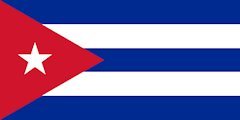 Cuba is not just a single island, though, perhaps only one of note – it consists of the main island, as well as a smaller one, the Isla de la Juventud, and a bunch of archipelago islands as well. In total it’s about 42,426 square miles, or slightly less than the size of the state of Virginia (not West Virginia, for a change). It has a population of 11.2 million, about 40% more than Virginia, and of those, only about 83,000 live on the second island, Juventud. It, in practice, if not theory, is run by a single political party, the Unitary Marxist-Leninist party, and, obviously, a socialist country of that stripe. About 65% of the population are, or “pass as” white, the remainder are almost all black (though my quotes on pass as are a nod towards the reality that the vast majority are mixed race). Surprisingly, only about 59% of the population are Christian, fewer than half are Catholic, around 18% belong to one or another “folk religion”, mostly Santeria, while 23% are declared as “unaffiliated”, no doubt a result of past repression of religious practice. I recently read an article about the Jewish community there, which at one time numbered in the tens of thousands, but now is only about 1200 people, at least who identify as part of the community.
Cuba is not just a single island, though, perhaps only one of note – it consists of the main island, as well as a smaller one, the Isla de la Juventud, and a bunch of archipelago islands as well. In total it’s about 42,426 square miles, or slightly less than the size of the state of Virginia (not West Virginia, for a change). It has a population of 11.2 million, about 40% more than Virginia, and of those, only about 83,000 live on the second island, Juventud. It, in practice, if not theory, is run by a single political party, the Unitary Marxist-Leninist party, and, obviously, a socialist country of that stripe. About 65% of the population are, or “pass as” white, the remainder are almost all black (though my quotes on pass as are a nod towards the reality that the vast majority are mixed race). Surprisingly, only about 59% of the population are Christian, fewer than half are Catholic, around 18% belong to one or another “folk religion”, mostly Santeria, while 23% are declared as “unaffiliated”, no doubt a result of past repression of religious practice. I recently read an article about the Jewish community there, which at one time numbered in the tens of thousands, but now is only about 1200 people, at least who identify as part of the community.
The slave population from Africa was a huge part of the colonial plantation era – in the early 19th century, when Cuba’s population was only about 600,000, around 225,000 of those were slaves and another 115,000 were freed, former slaves. The cuisine is a blend of Caribbean and Spanish cooking, and obviously incorporating many traditions from Africa.
I seriously considered making one of my favorite sandwiches in the world, the famed Cuban, as my “bread” component of this meal, though that felt like maybe too far of a stray from the project, and the bread used is a pretty basic white bread, similar to a baguette style. I decided to return to the early roots of the project, originally planned to be empanadas of the world, and went with Empanadillas. A lot of those in Cuban cuisine, lean towards the sweet side, and sweetened cheese, or guava paste, seem to be the most common fillings, and they’re often served alongside a coffee at a café. Savory ones appear less common, but they certainly exist, and I simply picked one with a different sounding filling from many of those I’ve done in the past – picadillo de cerdo a la campesina, or “peasant style” pork mince. For the soup, several possibilities, though the two that popped up most often seemed to be just versions of various Caribbean black bean soups or ajiaco-sancocho type soups, both of which I’ve made recently in the Costa Rican and Colombian entries. I ended up picking a more unique, if maybe less common, Caldo de camarones, or, shrimp broth.
Let’s make the filling for the empanadillas first – in fact, I made it the day before, it’s one of those things that is well suited to sitting a day to marry the flavors well. We have about a pound of pork mince, a third of a cup of peas, an onion, a green pepper, a couple of cloves of garlic, about a one third cup of tomato puree or sauce, and a half cup of white wine. Not pictured, because I forgot to put it on the board, a half a lemon.
In a splash of oil, cook down the chopped onion, garlic, and green pepper, with a little salt and pepper, until soft.
Add the pork mince, a little more salt and pepper, and cook until just browned.
Add the peas, wine, and tomato sauce and cook until the liquid has basically absorbed or evaporated and is just clinging to the mince mixture. Squeeze in the juice of the half lemon, adjust seasoning and set aside to cool – again, I recommend overnight in the fridge, I think it just tastes better the next day.
I don’t know how traditional this dough is, there were a ton of different recipes, but it was one of the more interesting sounding ones, so I went with it. We have a cup and a half of pastry flour, a teaspoon of salt, two of sugar, and one of baking powder, then a tablespoon and a half of butter, two eggs, and three tablespoons each of white wine and vegetable oil.
Rub the butter into the dry ingredients, and then add the rest. Now, it looked like there might be a bit much on the wet ingredients, so I added just one of the eggs to start, and then decided that I’d just use the yolk from the second egg or it would be too wet. Mostly that comes down to how big the eggs are – these were extra large. Let the dough sit, covered, for about half an hour.
I probably made these a bit bigger than empanadillas typically are, since the name implies “small”, but so be it. I divided the dough in eight equal parts, rolled them out into circles, and put a scoop of the filling on each.
Folded them over and sealed them with a little water.
And, I had vegetable oil heating up in a pan on the stove, ready for frying.
Brown them on both sides, and they’re ready to eat!
For the soup, we start with about a pound of peeled and deveined shrimp or prawns, an onion, a red bell pepper, a potato, three cloves of garlic, a carrot, some cilantro, salt and pepper, a good tablespoon of paprika (here you get to decide if you want to go sweet, smoked, or hot, to adjust how spicy you want it, I obviously went hot), a couple of bay leaves, and about a pound of tomatoes. Not pictured, two liters or quarts of shrimp stock – just simmering water with the shrimp shells and heads, a bay leaf, a smashed clove of garlic, a halved onion, and a couple of peppercorns for about thirty minutes.
Chop up the onion, garlic, bell pepper, and tomatoes and cook them down with a splash of oil and the salt and pepper. When the vegetables are basically falling apart, about 20 minutes in, puree them in a blender with about a cup of the shrimp stock.
Add the diced carrots and potato, along with the cilantro and paprika, to the pureed tomato mixture and the rest of the stock. Bring to a simmer and cook about 15 minutes.
Add the shrimp or prawns into the pot, bring back to a simmer, and cook about 10 minutes. Adjust the seasoning and remove the two bay leaves and the soup is done!
Serve it up! Now, the original empanadilla recipe had more salt in the dough – a full two teaspoons, and I found it too salty, which is why I cut it to one teaspoon in the recipe above. Other than that, these are delicious and I’ll make them again. I love the texture of the dough, it’s very light and flaky, and the filling, of which there was too much, is really tasty – I’m going to use the rest with some pasta. The soup has great flavor, but… although this is a “caldo”, a broth, and it’s intended to be more liquid than solid, I found the shrimp, potato, and carrot were kind of lost in a sea of liquid. If I was going to make it again, I’d cut the broth quantity by a quarter or third, and I think I wouldn’t puree the tomato mixture, I’d leave it as is and give the soup some more body. It might not be the traditional, but I’d like it better. Even as presented in the picture, I put more of the solids into the bowl than were proportional to the amount of broth. But flavorwise, I’ll happily make this one again.
Next up, we’re off to another large body of water as we visit Cyprus, in the Mediterranean. (We ended up having to go out of order, so the next one is actually Czechia.)
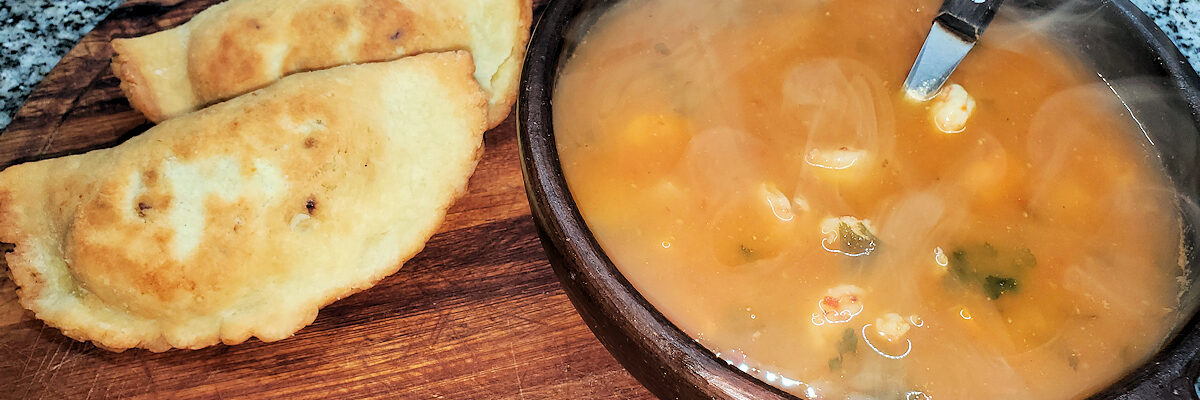
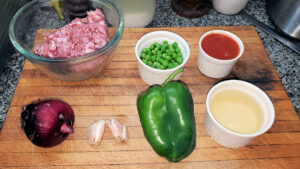
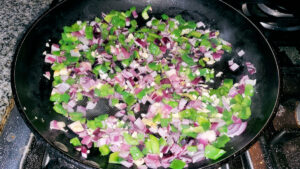
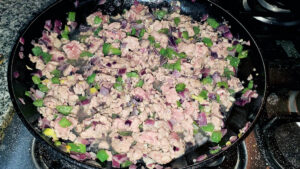
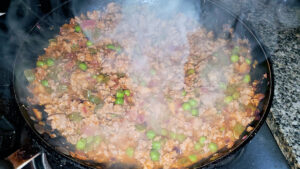
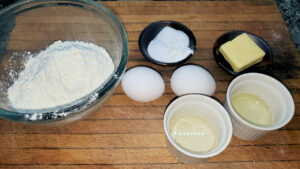
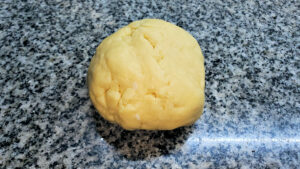
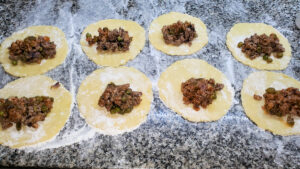
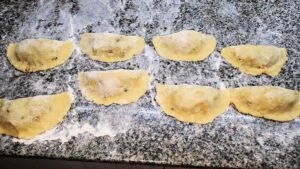
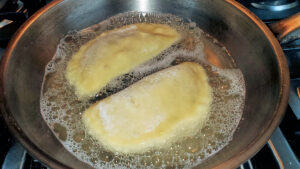
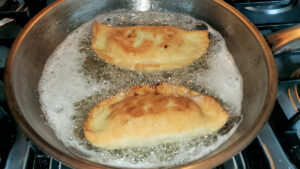
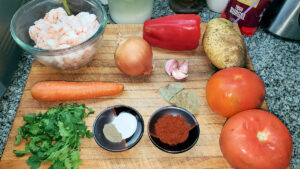
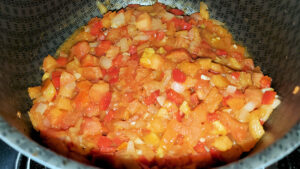
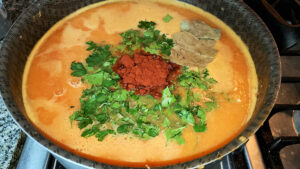
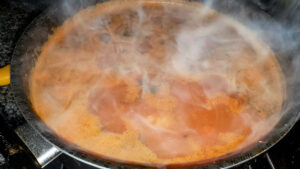
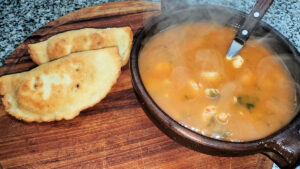
[…] with shrimp, potatoes, carrot. This was a soup I made as part of our Bread & Soup Project, for the Cuban entry, and you can find the details on making this soup […]